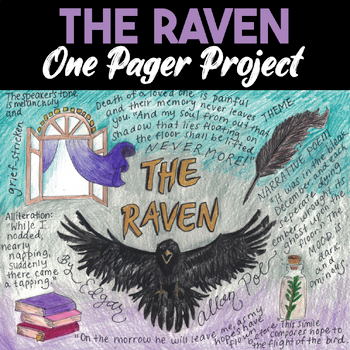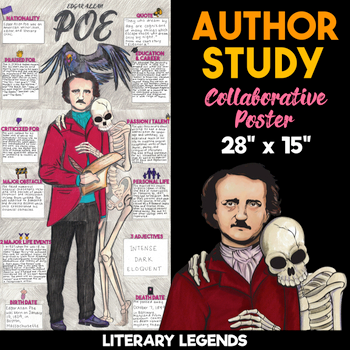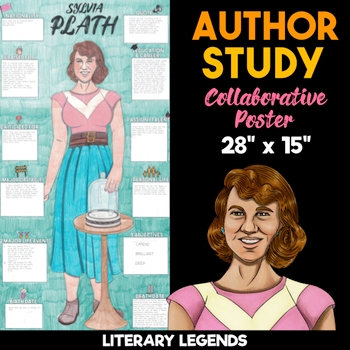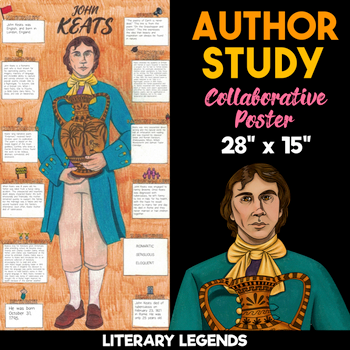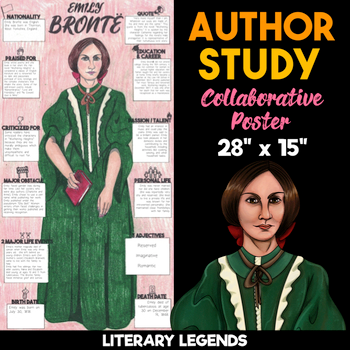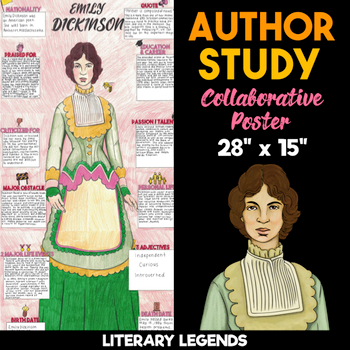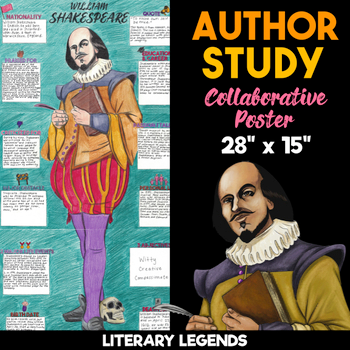Teaching Gothic literature and poetry? Worry Poe more! (See what I did there?) Read on for a list of 20 Gothic poems to teach your secondary students. From eerie undertones and haunted settings to tortured minds and cursed characters, these 20 Gothic poems cover it all. So read on and take your pick!
What Is Gothic Poetry?
Who’s more dramatic and emotionally distressed than your teenage students? Why, the characters in Gothic literature, of course!
Despite originating in the late 18th century, Gothic literature continues to captivate modern day audiences. Many of your students have likely seen shows like “The Vampire Diaries,” “American Horror Story,” “The Chilling Adventures of Sabrina,” “Teen Wolf,” and more. (Seriously, the list goes on and on.) The popularity of these shows reveal this generation’s fascination with the same elements made popular by Gothic literature. Think characteristics including feelings of mystery and suspense, grim undertones and settings, and supernatural elements. It’s also known to explore the darker sides of love and lust.
There are many different types of writing that can be considered Gothic poetry, often influenced by the time period the piece is written. However, one thing that doesn’t change regardless of when the poem is written? The author’s reliance on atmosphere and word choice to build strong emotion, often suspense and unease, in the reader. With that said, Gothic poems often feature themes of darkness, death, and internal conflict.
Gothic poems are easily identified by their dark undertones of dread, suspense, and fear. (Think abandoned Victorian mansions, squeaky floorboards, and flickering candles to set the mood.) The popular use of omens, visions, and curses in Gothic poetry provide a great opportunity to teach about foreshadowing as a literary device. Lastly, Gothic poets often write to convey a sense of heightened emotions and distress, which your teenage students are certainly likely to find #relatable. (Think teenage angst multiplied by a million.)
Engaging Your Students With Gothic Poetry.
The bottom line? Students are fascinated (and easily engaged) with the suspenseful and spooky, especially when fictitious literature provides a protective barrier from any real danger. However, it doesn’t have to be spooky season to dive into Gothic poetry. Your students will be able to draw connections between classic Gothic poems and modern day themes all year long.
So, without further adieu, here’s a list of 20 Gothic poems to teach your secondary students.
Best Gothic Poems To Teach By Edgar Allan Poe
- “The Haunted Palace” by Edgar Allan Poe
What better way to teach students the elements of Gothic poetry than with the works of Mr. Poe! “The Haunted Palace” is a six stanza poem loosely following an ABABCDCD rhyme scheme. Students can analyze the poem, stanza by stanza, identifying the ways in which Poe illustrates the dreary transformation of a once “stately” and “radiant” palace. See how many details they can pick out as the palace’s“glow” slowly dims, replaced by grimness and sorrow. And while some analyze the poem as a metaphor for depression, have fun letting students come to their own conclusions! (That’s the beauty of literature, isn’t it?)
In addition to its Gothic elements, “The Haunted Palace” is a great opportunity to teach about literary devices such as hyperbole and alliteration.
- “The Raven” by Edgar Allan Poe
Perhaps Poe’s best known poetic masterpiece, “The Raven” is a narrative poem exploring intense grief and loss. The poem is written in 18 six-line stanzas and follows the ABCBBB rhyme scheme, creating an alluring rhythm as you read. Be sure to read (or listen to) this eerie poem aloud, giving students a chance to feel the growing sense of anxiousness the speaker feels over the course of the poem. Ask students to unpack the ominous undertones and descriptions throughout the poem and how they add to the element of sorrow and suspense.
Aside from all its Gothic glory, “The Raven” is a great example of the power of repetition in a poem, using the haunting line “Nevermore” to end several stanzas.
- “Alone” by Edgar Allan Poe
Poe is back with another poem filled with sorrow. (His specialty.) “Alone” is a 22-line lyrical poem in which the speaker gloomily reflects on their life, seeing a somber and demonic darkness where others see Heaven’s blue. And thus, Poe skillfully mixes loneliness with pessimism for a dark undertone of what many look back on fondly: childhood. Have your students track the juxtaposition, noting where Poe turns a usual nostalgic moment into something bitter and grim, adding to the dark undertones of the poem.
“Alone” is a great example of AABB rhyme structure. Additionally, it gives students a glimpse into the use of enjambment as a literary device in poetry.
- “Annabel Lee” by Edgar Allan Poe
With his poem “Annabel Lee,” Poe skillfully takes the reader on an emotional ride. What starts off sounding like a fairytale romance, the poem’s tone throws a chilling curveball as the wind sweeps in, “chilling and killing” the speaker’s true love. Poe masters the Gothic art of creating an eerie tone with carefully selected words and phrases. Yet, he creatively intertwines this tone with a rhythm much like a nursery rhyme. Likewise, the ABABCB rhyme structure adds an extra element of suspense for the reader. Have students analyze the stark contrast between love and death in this six stanza poem.
Poem’s “Annabel Lee” provides exciting (yet dark) examples of personification as he gives the wind the capability to kill Annabel as if it were a murderous human.
- “The Bells” by Edgar Allan Poe
Poe achieves Gothic mastery yet again with this four-part poem. This musical poem brings the reader on a melodic ride as each part portrays a different feeling through a set of large iron bells. While the poem begins by denoting a sense of pleasure and sing-songy joy, it takes a sudden and dark turn. All the while, the rhythmic song of the bells turn from pleasant to suspenseful. What was once a joyful ‘tune’ turns into a warning of an approaching terror.
In addition to analyzing the Gothic element of “The Bells,” the poem showcases an effective use of a refrain at the end of each stanza, giving it such a rhythmic flow.
- “A Dream Within a Dream” by Edgar Allan Poe
Students will be wondering if the speaker is trapped in a dream or a nightmare in this poe(m). Poe creates a feeling of anxiousness as the speaker faces an existential crisis, realizing the fleeting nature of life and its experiences. Despite being less dark than some of Poe’s other works of Gothic literature, “A Dream Within A Dream” manages to portray feelings of gloom and doom through the notion of the speaker’s sense of helpness and hopelessness.
Additionally, you can use this poem to showcase the effective use of a rhetorical question as a literary device. Have students analyze the device’s purpose and effectiveness.
Other Popular Gothic Poems To Teach
- “Goblin Market”by Christina Rossetti
Despite being a longer poem (29 stanzas!), Rossetti’s narrative “Goblin Market” is a surprisingly fast read. Perhaps it’s the nursery rhyme-like rhythm, the fast-paced lines, or the ABAB couplet rhyme scheme. Regardless, Rossetti highlights sinister themes of desire, temptation, and evil through the tale of two sisters walking through the market. While the poem might seem innocent on the surface, there is a menacing tone lurking below.
As a bonus, Rossetti skillfully crafts similes throughout the poem as a way to conjure up images of the market’s goods.
- “Lady Lazarus” by Sylvia Plath
Sylvia Plath is a poetic master of deep suffering. Written in the months before her suicide, it is beleived that Plath wrote “Lady Lazarus” as an expression of her personal turmoil. Despite the dark subject, her poem explores a deep agony in a strangely beautiful way, moving the reader to truly feel the emotions in each word. As the students analyze this famous lyrical free-verse poem, be sure to point out Plath’s use of the biblical allusion behind “Lazarus,” noting how she creatively turns on the comparison.
A warning for teachers: This takes somber and sorrow to a new level and may contain sensitive material as Plath explores suicidal thoughts and attempts.
- “Spellbound” By Emily Brontë
A short but powerful poem, Emily Brontë’s “Spellbound” provides an interesting look into the Gothic genre. While it is unknown for certain what “spell” the speaker is under, the reader understands the sense of impending doom to come. The speaker is immobilized by a “tyrant spell,” repeating the use of the phrase “cannot go” for dramatic effect. While some critics take the poem to be an allusion to the struggle between life and death, others between heaven and hell. Sit back and watch your students come to their own conclusion!
Also, take advantage of the opportunity to teach students the power of setting as a way to set the mood of a poem. Be sure to point out how the dreary weather conditions in the first two lines set the tone effectively.
- “Ode On Melancholy” by John Keats
Keat’s poem focuses on the Gothic elements of inevitable doom and death. Students will get wrapped up in the speaker’s dreadful look on life and happiness, emphasizing the unavoidable sorrow humankind must face. Written in a melancholic tone, this poem looks at life through a very Gothic lens. As such, ask students to translate Keat’s words to modernize his anxious rambling.
Additionally, this poem is a perfect way to introduce an ode, explaining how it is crafted as an emotional tribute to a person, place or thing (in this case, melancholy).
- “The cold earth slept below” by Percy Bysshe Shelley
Some critics believe the poem was written as a raw and sorrowful response to the loss of his first wife to suicide. Others believe it to be about the death of a woman lured into a cold night by a haunting phenomenon in the water. Regardless, no one can deny the poem’s dark tone and Gothic elements.The poem is divided into four stanzas, each explaining an unfortunate encounter on a freezing winter night. As you read, ask students to note the ways Shelley describes the desolate and dark settings to lay the foundation for a haunting tale.
“The cold earth slept below” provides students an excellent opportunity to explore the effective use of imagery and personification to create unforgettable (and rather chilling) descriptions.
12. “Remembrance”/”Cold In The Earth” by Emily Brontë
Another great Gothic poem by Brontë, “Remembrance” explores the themes of grief and death. The speaker mourns the death of her first (and only) love, expressing her struggles with a deep sense of loneliness. As the speaker grapples with her loss, she ultimately “check[s] tears of useless passion” in an attempt to free themselves from their pain and sorrow. By the poem’s end, have your students decide if the speaker is set free of their sorrow or forever a prisoner of their pain.
This eight stanza elegy is not only an opportunity to explore this type of poem, but is an example of how seasons (in this case winter) can be a symbol, helping set the overarching theme and tone.
Gothic Poems You Might Not (But Should) Teach
- “Burning Oak, November” by Joyce Carol Oates
Joyce Carol Oates is considered a contemporary Gothic, carrying over Gothic elements into her often somber works exploring modern society. In this poem, Oats looks at the decline of American society through the irreversible impact of modern innovation and advancement. Using the symbol of the burning oak, Oats highlights the unfortunate conflict between man and the beautiful wonders of nature. Though the poem is four comprised of four stanzas, it isn’t until the very last line that the speaker delivers the final blow emphasizing the hopelessness and loss experienced by modern society.
Look for a fun extension? Consider having students compare classical Gothic literature to this more modern version, noting the similarities and differences.
- “The Shadow on the Stone” by Thomas Hardy
Thomas Hardy is known for his collection of somber poems written in the wake of the sudden death of his first wife. Filled with emotion, “The Shadow on the Stone” follows a man struggling with grief over his wife’s death. (Coincidence? I think not.) Over the course of three stanzas, readers follow along as the speaker balances a mix of fear and hope as he feels a ghostly presence wherever he goes. Though notably less “spooky” than other poems on this list, Hardy produces a skillful mix of dread and hope.
Seeing that much of Hardy’s work reflects his life, this poem lends itself to a conversation about how art often imitates life.
- “Going” by Philip Larkin
Larkin depicts the Gothic themes of death and doom in this memorable poem. Despite never calling death out by name, the “never seen” evening acts as a symbol for impending death all men will experience. Playing off the reoccurring blackness (both directly and indirectly), Thomas gives death an all-consuming power. As the speaker emphasizes a growing concern and confusion, the reader understands the lack of hope and inescapable doom the speaker feels.
While this short poem is separated into three main stanzas, it’s a great opportunity to discuss the impact of the ending monostitch.
- “The Moon and the Yew Tree” by Sylvia Plath
This one of Plath’s poems is noted to be particularly ambiguous, leaving much room for student interpretation. One thing not up for debate? The sense of dark disillusionment throughout the four stanzas. Plath often references religious elements (God, the Resurrection, Mary, and church pews), hinting at Plath’s feelings toward the Catholic church. Regardless, the grim setting adds to a sense of hopelessness as the setting is filled with dreary descriptions. From “grief” stricken grass and “spirituous mists” to the “black” and “Gothic” yew tree, a sense of death appears to be all around. Plath’s word choice reflects the speaker’s discomfort, dissatisfaction, and cold and lifeless outlook.
Aside from the ominous examples of personification noted above, Plath’s poem is filled with literary device. Have students search for personification throughout the piece, analyzing its effect on the poem as a whole.
17. “Medusa” by Carol Ann Duffy
Despite its light rhythmic flow, Duffy writes “Medusa” as a tale of the dark side of love and lust: jealousy. Referring to the mythical Medusa in the title, the speaker appears to embody the bitter, murderous creature as if bringing her to life. With its dark Gothic tone, Duffy is able to highlight both a sense of tragedy and revenge throughout the eight stanzas. While the speaker seeks revenge on her unfaithful husband, she hints toward her own insecurities in the final lines.
With obvious references to Greek mythology, “Medusa” is a perfect example of how to use allusion as a way to emphasize a particular tone and theme throughout a poem.
- “I felt a funeral in my brain” by Emily Dickinson
Dickinson’s “I felt a funeral in my brain” is often viewed as an exploration of madness, with the speaker falling deeper and deeper into a grim fate. The poem begins with an attention-grabbing juxtaposition between life and death, setting the tone for the entire poem. It successfully gets readers thinking, how do you feel a funeral? What might that feel like? With that, students can understand the power of such a juxtaposition to evoke certain feelings and curiosities in the reader. From there, Dickinson deepens the feelings over the course of the poem, taking the reader down the spiral of the speaker’s loss of control. Ultimately, the poem ends abruptly before any answers (for the speaker or reader) are achieved.
Have students track the funeral metaphor throughout the poem’s five stanzas, noting how Dickinson uses a funeral to represent the speaker’s demise from within.
19. “The New House” by Edward Thomas
Don’t judge a (Gothic) poem by its title! Thomas proves this to be true with his poem “The New House.” In just 16 lines, Thomas masterfully stings each line together, inviting his readers to experience a sense of mourning and grief that have yet to occur. It’s a somber poem with a rather unique approach, using the new house as a metaphor for life’s unavoidable truths, including loss and grief. Once “the wind began to moan” the speaker is immediately reminded of the dark road ahead.
In exploring symbolism and setting, ask students to consider Thomas’ ironic use of a new house for this particular poem when an old, rundown house would be a more obvious setting.
- “Double, double toil and trouble” by William Shakespeare
Students may recognize this poem as one of the songs of the Witches from “MacBeth,” but it makes for a fun Gothic analysis! Despite being published before the Gothic genre took off in the late 1700s, Shakespeare’s poem embodied many essential elements of Gothic literature. Have students read along as the speakers of the poem (the Witches) call the dark forces with their frightening potion. Following an ABAB rhyme scheme, this poem’s sing-songy melody makes the evil happenings all the more frightening.
This is a great poem to analyze as a nod to the Gothic genre, especially around Halloween!
The bottom line? Students will be fascinated by the grim and macabre undertones of the works of poets like Edgar Allan Poe and Christina Rossetti. (And more!)
So, whether you’re looking to complement your study of longer works of Gothic literature, such as Poe’s “The Tell Tale Heart” or Mary Shelley’s Frankenstein, or simply explore the genre through a selection of poems, this list has plenty to choose from.
And with that, happy haunting (errr… I mean reading) my fellow teachers!

